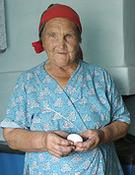 被外界所遺忘的哈薩克核子武器試爆區,近20年來一直都是荒廢狀態,但專家表示除非完全移除整個試爆區,否則外洩輻射將持續危害居民的健康。
被外界所遺忘的哈薩克核子武器試爆區,近20年來一直都是荒廢狀態,但專家表示除非完全移除整個試爆區,否則外洩輻射將持續危害居民的健康。
自1991年該區就封閉成為核武試爆區,而2008年9月一國際組織¬「全面禁止核子試驗條約組織」(Comprehensive Nuclear Test Ban Treaty Organization)開始在塞米巴拉金斯克核子試驗場(Semipalatinsk Site)進行一連串的儀器測試,以鑑定出核子試爆的痕跡。
之所以選塞米巴拉金斯克核子試驗場的原因是因有些測試可透過實地檢驗測出,例如包含在土壤及大氣中的輻射程度等。此外哈薩克獨立後不久,就發出聲明表示成為第一個自願放棄核武的國家,而塞米巴拉金斯克州被視為是最好的證明。
和輻射如此深厚的歷史淵源,讓塞米巴拉金斯克州至今仍生活在輻射的遺害下。學術人員與人權團體表示鄰近塞米巴拉金斯克州的地區,居民罹患癌症、先天性缺陷、發育遲緩、神經失調等的機率,相較於哈薩克其他地區都高出許多。
根據哈薩克東部地區癌症中心的紀錄顯示,該區病發率比全國平均高出10到15%,且大部分患者的年齡落在50至60歲這個層級,也就是那些在核子試爆行進中,身處周圍的人們。
其中,在地上進行的核試一直到1962年結束,但地下的核試又持續了許多年,直到1989年才終止了該計畫。然而大約有170萬人因輻射外洩而引發健康問題。

這些日子以來,輻射程度已大幅下降。但專家提出警告表示,少量且持續的外洩輻射會衍生基因突變而產生畸形的問題,且除非試爆區完全清除,不然情況會一直持續下去。
Kazakstan's nuclear test zone has lain deserted for the last 20 years largely forgotten by the outside world, but experts say radiation will continue to be a health risk until the huge site is cleaned up thoroughly.
The testing ground was closed for use in 1991. This month, the international Comprehensive Nuclear Test Ban Treaty Organization is running a series of trials at the Semipalatinsk site to test equipment that can identify and give the location of nuclear explosions.
Semipalatinsk was chosen for the experiments because some of the testing can be done for real, for example checking radiation levels in the soil and atmosphere. In Kazakstan, it also is being seen as a tribute to the country's decision, soon after it became independent, to become the first state to voluntarily renounce nuclear weapons.
The persistence of high background radiation means the legacy of Semipalatinsk lives on. Academic researchers and pressure groups say the incidence of cancer, congenital defects, retarded development and psychiatric disorders in the surrounding area is much higher than in other parts of Kazakstan.
According to the cancer center for East Kazakstan Region, the disease occurs 10 to 15 percent more frequently than the national average, with a high proportion of cases falling within the 50-60 year-old age bracket - people who would have been around when nuclear testing was taking place.
Above ground blasts ended in 1962, but underground testing continued for many years until the program ended in 1989.
Some 1.7 million people are believed to have health problems caused by exposure to radiation.
These days, the radiation is at much lower levels. But experts warn that low doses and constant exposure can show up as genetic malformations. This is likely to persist until a complete clean-up is conducted over this vast testing area.

